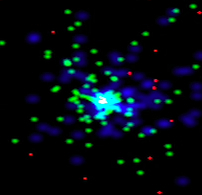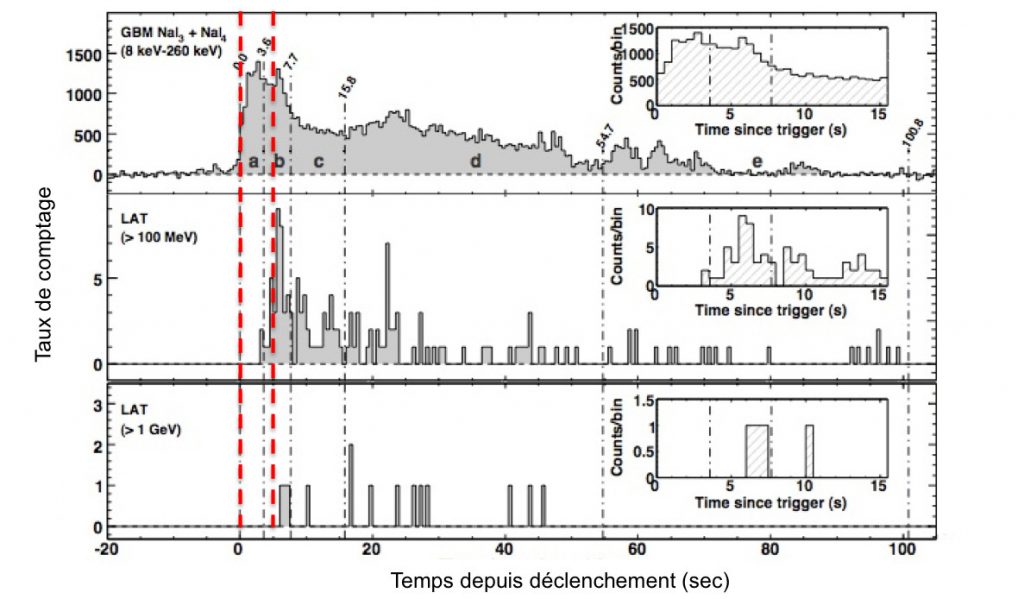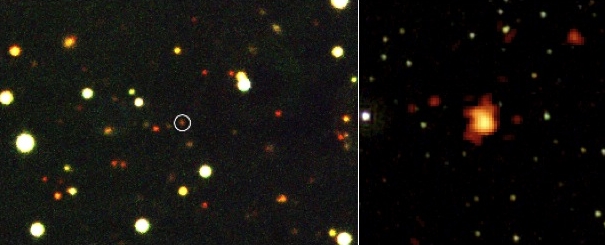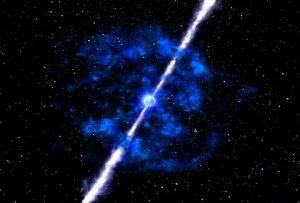The FERMI observatory has discovered the most energetic gamma-ray burst ever detected
The Fermi gamma-ray space telescope [1] has detected the most violent gamma-ray burst ever recorded; a gigantic explosion marking the death of a massive star. Light from this explosion, captured by the Fermi observatory on September 16th 2008, had taken 12.2 billion years to reach Earth. Hence, it must have been produced at a time when the Universe was just 1.5 billion years old. The total amount of energy released makes this the most violent explosion observed in the Universe since the Big Bang. Observed by the Fermi on scales covering more than six decades in energy, this gamma-ray burst demonstrated exceptional properties. Clouds of charged particles were catapulted out during the explosion, at a speed equal to 99.9% of the speed of light! This work, the result of the international Fermi collaboration, with partners from CEA-Irfu, was published on February 19th 2009 in the journal Science express.


An extraordinary burst in many aspects
Even though, thanks to the satellites dedicated to their study, gamma-ray bursts are regularly detected these days, still these short-lived but very violent bursts of high energy rays have not yet finished providing surprises for the scientific community. The gamma-ray burst GRB080916C (C for 3rd Gamma Ray Burst detected on the 16th day of September 2008) was not at all usual, as the Fermi observations showed it to be the most energetic burst ever detected; even if it did not gain the distance record held by GRB080913, a surprise from three days earlier. The energy released during the explosion of the star surpassed that of a “classic” supernova by a factor of a hundred, if we consider the emission as coming from a narrow cone pointing towards the Earth.
The gamma-ray burst detected by the Fermi also showed some remarkable properties: a 23 minute duration of prompt emission at high energy and a delay of 5 seconds between the most energetic photons (greater than 100 MeV i.e. 100 million electron-Volt [2]) and those at low energy (less than 1 MeV). The hypothesis put forward by scientists to explain this delay relates to distinct emission zones. They also suggest the possibility that different types of particle are accelerated by successive shocks produced in the explosion. This is significant if we wish to improve our understanding of the acceleration mechanisms of these particles.

For this burst, the most energetic photon recorded by the Fermi had an energy of 13 billion electron-Volts (13 GeV). To produce photons with this energy requires particles accelerated to speeds approaching the speed of light. In fact, the observations by Fermi have enabled calculations to be made which show that the plasma clouds catapulted into space at around the time of the explosion, were ejected at 99.9999% of the speed of light. Gamma-ray bursts such as GRB080916C are therefore good candidates to explain the origin of ultra-high energy cosmic rays, which have been the subject of intense research in recent years, notably since the commissioning of the Auger network.
Film of the discovery
The burst was detected on September 16th 2008 at 00:12 Universal Time by the “Gamma-ray Burst Monitor”, GBM. This instrument, specially dedicated to the hunt for gamma-ray bursts, is continuously scrutinising large areas of the sky using its 14 detectors. The LAT telescope, the main instrument of the FERMI observatory, was alerted and, one minute later, had delivered the celestial co-ordinates of the event, enabling it to be tracked by X-ray satellites and ground based optical telescopes. Observations in the visible region enabled the red-shift of the light from the burst to be determined as being 4.24, indicating that the explosion took place 12.2 billion years ago. Observations carried out in the X-ray and optical regions enabled the later phases of the phenomenon to be studied, the afterglow emission, demonstrating the braking of the plasma of particles ejected during the explosion, when they encountered interstellar clouds in the surrounding medium.

Press contact: Isabelle GRENIER
“Fermi Observations of High-Energy Gamma-Ray Emission from GRB 080916C”
The Fermi collaboration
in the journal Science express on February 19th 2009.
For an electronic version (format PDF, 1 Mo)
See:
|
|
The CEA/CNRS press release (in french) |
|
|
The NASA press release |
For further information:
|
|
Le site Fermi du Service d’Astrophysique du CEA/Irfu (in french) | |
|
|
Images gamma de l’Univers (26 août 2008 , in french) | |
|
|
A la découverte de l’Univers extrême (11 juin 2008, in french) |
|
|
Le Fermi website at NASA |
Notes:
[1] FERMI. The FERMI space observatory is the result of an international collaboration including the United States who manage the project, as well as Germany, France, Italy, Japan and Sweden. In France, five laboratories are involved in this programme: The Service d’Astrophysique, AIM laboratory and Sédi from CEA-IRFU and four CNRS laboratories: the Centre d’Études Nucléaires at Bordeaux Gradignan (CENBG), the Centre d’études spatiales des rayonnements (CESR, CNRS / Université Toulouse-III), the Laboratoire Leprince-Ringuet (LLR) at l’École Polytechnique, and the Laboratoire de Physique Théorique et Astroparticules (LPTA) at Montpellier.
[2] Electron-volt. X-ray and gamma-ray energies are often expressed in “electron-volts” (eV). This unit corresponds to the energy given to an electron of charge (e) when it is subjected to a potential difference of 1 Volt. In SI units, système international, 1 eV is equal to 1.6 10-19 Joules. Rays (or photons) of visible light have an energy of around 2 eV, X-rays of from 0.1 to 511 kilo-electron-volts (keV). The gamma-ray region is situated beyond this limit. They are measured in MeV (millions of electron-volts 106eV), GeV (Giga or billions 109eV), TeV (Tera or thousand billion 1012eV), etc….
Edited by: Christian Gouiffès, Isabelle Grenier



